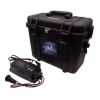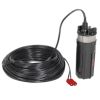Proactive Abyss Plastic Pump
Features
- Operates under harsh conditions and high turbidity
- Pump can run continuously in water without the need for a cool down
- 3000 hour motor life provides an economical sampling and purging solution
- Free ground shipping
- Expedited repair and warranty service
- Lifetime technical support
- More
Overview
The Proactive Plastic Abyss pump is capable of pumping up to 220 feet from ground level by simply connecting it to a 12-volt battery. Its reliable design is suitable for continuous sampling and purging of groundwater wells. The Proactive Plastic Abyss pump's sleek outside minimizes well hang-ups and easily fits into 4-inch wells or larger.
Applications
Its reliable design and low amp consumption make it the ideal pump for a remediation pump and treat system. The Abyss pump can run continuously, 24 hours a day, 7 days a week, for remote situations when the pump needs to run and no technician is present.
Solar Option
Simply hook up the desired solar panel arrangement to the 80 Amp Solar Charger and then to a deep cycle marine battery(ies) for a turnkey solar pumping system that will last for years.
- Power Consumption: 60 Watts (max)
- Volt Recommendation: 12-15V at source
- Maximum Amp Output: 4 Amps
- Measurements: 12" length x 3.82" diameter
- Use With: Optional Low Flow Sampling Controller
- Required Tubing: 3/8" or 1/2" ID tubing
- (1) 12V Engineered Plastic Abyss pump with 230' wire lead
- (1) Set of 12V battery clamps
In The News
SUNY ESF/Syracuse U. study finds in-stream restoration structures effective
Planning stream restorations is becoming more important as the number of projects increases nationwide, in efforts to enhance water quality and habitat health of surrounding areas. Researchers at the State University of New York College of Environmental Science and Forestry (SUNY ESF) and Syracuse University led a study of two streams in upstate New York that had undergone restoration. They found restoration work created large areas of "transient storage" where water is temporarily retained behind restoration structures that enhanced downwelling to rates not observed in reference reaches. In natural streams, these transient storage zones are known to host biological and chemical processes that allow the stream to clean itself.
Read MorePuget Sound sediment study looks to fill degraded inlet's data gap
Sediment in Washington State’s Puget Sound is growing more polluted, and scientists aren’t entirely sure why. Water quality specialists from the U.S. Geological Survey aim to change that. The Washington State Department of Ecology recently reported that some aspects sediment health in the sound have gotten worse over the last decade. Poor sediment quality has adversely impacted macroinvertebrates and water quality. A new USGS study is tracing Puget Sound sediment upstream to its tributary rivers to evaluate sediment volumes and quality.
Read MoreChoptank River watershed nitrate monitoring targets conservation efforts
A nutrient monitoring effort throughout a degraded Chesapeake Bay watershed is helping chart the path of nitrate through the system. The monitoring is part of a plan to target federally funded agricultural conservation practices to the places in the watershed that need them most. The Choptank River is among one of the largest tributaries to the Chesapeake Bay, a system plagued by excess nutrients. The Choptank flows across the Delmarva Peninsula, a 170-mile-long piece of land that makes up the bay's eastern shore. More than half of the Choptank's watershed is covered in agricultural land, which is part of the reason the river has been listed as impaired under Clean Water Act standards for nutrients and sediment.
Read More
















